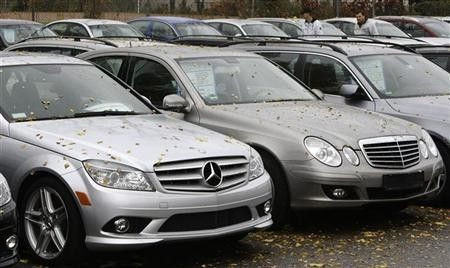Subprime Is Back For Auto Loans, Boosting Sales, And Worries

The number of subprime loans for automobiles increased this year as lending standards have loosened, boosting automakers' revenues but also creating fears of another financial bubble.
Around 15 percent of new car buyers had FICO credit scores below 650 in the first half of 2012, up from 10.4 percent in 2009, according to Thomas King, senior director of automotive analysis at J.D. Power and Associates. In the past three years, subprime borrowers have increased to around 1.5 million this year from 970,000 in 2009. However, the subprime market share is still below the 20 percent of such borrowers in 2004, which was a larger overall market.
The caveat is that the industry size has also changed, said King of subprime auto loans. In absolute terms, it's still a much smaller volume.
Subprime lending has helped increase sales for companies including Chrysler Group LLC, part of Italian Fiat SpA (Milan: F), Ford Motor Co. (NYSE: F) and General Motors Co. (NYSE: GM), which all reported increases in new car sales in June. Analysts say that the overall market for new retail auto sales is still largely composed of buyers with strong credit, with three in four borrowers having prime or better credit scores. But those with lower scores must pay much higher interest, in some cases exceeding 20 percent.
The rise in subprime lending is indicative of a market returning to a normal balance and isn't cause for alarm, said analysts. Lenders have been able to access credit markets more freely as the national economy improves, and the U.S. Federal Reserve's Term Asset-Backed Securities Loan Facility (TALF) program also unlocked more financing for auto loans.
I think it's the market settling back into equilibrium, said Alec Gutierrez, senior market analyst of automotive insights for Kelly Blue Book.
But Moody's Investors Service said in a June report that the subprime auto lending market resembled the early 1990s ramp-up in subprime mortgages, with the similar characteristics of easy credit and potential defaults by borrowers.
It is too early to predict whether today's subprime lending market will deteriorate as it did in the 1990s, but the early similarities between then and now suggest that losses will climb if competition intensifies, says Peter McNally, vice president of Moody's and author of the report, in a statement.
Auto loans, like mortgage loans, are securitized and sold to investors, creating potential profits -- and losses -- for a variety of financial institutions. And investments have increased greatly this year. In June, Santander Consumer USA priced $1.4 billion in subprime auto loan-backed securities, the largest such offering since 2007. Total subprime securities have totaled around $10 billion year-to-date, 20 percent more than the same period last year, according to Barclays data cited by Dow Jones.
Investors are attracted to the high yields compared to Treasury bonds and traditional prime loans. Subprime auto loans backed securities rated by Moody's since 2010 have yielded around 17 percent of their loans per annum, said the ratings agency. Net losses have been low, around 1 to 3 percent.
While there are similarities between subprime auto loans and mortgages, there are major differences between cars and home. Many Americans depend on cars to go to work and shop, making them reluctant to voluntarily default on their loans. In contrast, some homeowners have chosen to default on their mortgages in the wake of the recession, because the value of the home has shrunken below the balance of the loan, known as underwater mortgages.
The repossession process for automobiles is also much quicker than the foreclosure process, which requires judicial approval in some states. As a result, thousands of properties remain in ownership limbo, with some former homeowners continue to live, rent-free, as ownership is sorted out. In other cases, empty properties are neglected and fall into disrepair, with no buyers in sight.
In contrast, repossessing automobiles is a much quicker process for lenders, whose main challenge is finding the location of the vehicle. The robust market for used cars and tight inventory also makes it easier for lenders sell repossessed vehicles.
We're still seeing a shortage of vehicles in short sale options, said Gutierrez of Kelly Blue Book. Thus, the fallout of borrowers defaulting on their loans isn't expected to have a large negative impact on the auto industry under current market conditions.
© Copyright IBTimes 2024. All rights reserved.




















